This post was generated by and redirects to https://www.pcouncil.org/events/southern-oregon-northern-california-coast-coho-workgroup-to-hold-online-meeting-august-6-7-2020/.
Updates
Pacific Council News Summer 2020
An interview with Don Hansen

This is the first of a three-part interview with Don Hansen. Don founded Dana Wharf Sport Fishing and Whale Watching, along with the Festival of the Whale in Dana Point, California. He was involved in the development of the first West Coast fishery management plans under the Magnuson-Stevens Act. Don served on the Groundfish Advisory Subpanel from 1981 to 2000, on the Council from 2000 to 2009, and as Council Chair from 2003-2009. He has served as an Inter-American Tropical Tuna commissioner and as the Chairman of MAFAC, the Marine Fisheries Advisory Committee.
I started in 1946 down on the pier, pulling a wagon up and down the pier, taking peoples’ fish from the end of the pier to their cars, and I went from there to where I am now – which is not much further.
We were down in San Clemente Pier then. Dana Point Harbor wasn’t even built. Dana Point Harbor is 50 years old right now. We were on the pier at San Clemente, which is about 10 miles south of Dana Point. When I got to San Clemente there was 575 people in the whole town, and there’s now 100,000, so, yeah, things have changed. Yes they have.
People that caught fish on the boats, they had a long walk up the pier to the parking lot to their cars, so you’d take your fish, put it in a wagon and haul it all the way up there. They’d give you tips – 10 cents, a quarter – 15 cents, whatever. I didn’t get rich, but I had candy money. It [was] a perfect job for a kid. You couldn’t get in trouble; if you wanted to you just went swimming until the boat came in, because you were right there at the pier. The ocean was right there, you could play around in the ocean all day until the boats came in, and then go do your job. It got to be a little competitive.
[Later] I fished as a deckhand, and then I went from a deckhand up to the captain, and started running boats. I was going to college too. [Eventually] I went back to work for the company running boats, and then when they put the business up for sale, and I was lucky enough to have a customer who loaned me the money to buy the fleet and the business known as San Clemente Sportfishing. I’ve been doing that for the last 60 years.
I got a license from the Coast Guard and ran boats, myself, for oh, 30 years. My kids run the whole operation now.
The first boat I worked on was the Reel Fun; it was 1952. I was just out of high school, and they were building that boat. I had a real important boat builder job: I was very, very important. They made me get the board stretcher and the sky hook and all those things that don’t exist. “Go get me that board stretcher over there.” “Oh, OK, yeah…”
So that was that first boat. That was 1952. I still have it! It still runs every day. And then I built the Sum Fun, 1960, a 65-foot boat. And then the Clemente is also a 65-foot sportfisher, and then 15 years ago, in Hoquiam, Washington, we built the Dana Pride, 95 by 30. It’s a big boat. It’s solid glass. You can take a sledgehammer and hit it and it will bounce back at you. I have three boats that are steel, and three boats that are wood, and the fiberglass boat. And three other fiberglass boats. The whale watch boats are fiberglass. They’re catamarans.
The best thing I ever built was the Dana Pride, because it is exactly the same way it came out of the yard up there. It hasn’t been painted yet. It doesn’t need paint: you just polish it.
I built a lot of boats and ran a lot of boats. I ran to San Clemente Island every day all summer long – five hours over, five hours back. It’s 60 miles offshore. We went there and fished albacore for years and years… and the albacore disappeared. We’ve seen one stock after another disappear in the ocean. But they come back! They always come back. I hope this year we see albacore again down here. But the groundfish have pretty well all returned; we could take all the credit at the Council process level, but I think God had a lot to do with that. The conditions change; the ocean changes; stuff like that: things change. But I like to say we did it. The Council did it. Because I never forget when we’re talking about rebuilding cowcod, and I was the chairman, and they told me “it will never rebuild in your lifetime.” Well, it’s rebuilt and I’m still alive. The Council’s done a good job, the science has done a good job.
We used to catch a lot of fish. We’re not catching fish like we used to in the years gone by, but where are they? I don’t know where they are. The barracuda and big bonita, they go in cycles, and they’re not here right now. But that was fun – everybody’d get their limits of fish, which was more than they needed.
People release most of their fish now. It’s catch and release, and if they have a good day, they’ll take a couple fish home for dinner, but they don’t hog it like they used to do. They don’t fill their limit. [Back then,] if it was a fifteen fish limit, they’d take 15 fish. Now, they take what they actually need and release most of the rest.
Now, nobody wants to catch the last fish in our industry, because if we catch the last fish we’re out of business. We didn’t know about barotrauma at that time. Ninety percent of our fish in those old days were not rock cod. It was all surface fish – barracuda, bass, bonita, tuna. Only in wintertime did we fish rockfish. And we didn’t want to fish a lot of rockfish, and we didn’t have to. But now we have to in the wintertime, because they’ve got us shut down… the state’s got so many restrictions on our fisheries anymore… It’s tough. And it’s tough to charge what you have to charge now to go fishing and come back with nothing. And that’s the sad part. That’s what frustrates me, and the sea lion issue. You take your daughter fishing or your son fishing, and they catch a nice fish and a sea lion comes up and eats it.
But back to rockfish – sending the [descending] device back down there to release the rockfish, I think it works. The scientists at the Southwest Fisheries Science Center show that they live… they go down fast, and they automatically release at the depth they want them to release at. They swim away. It’s amazing. It works.
Coastwide enforcement update
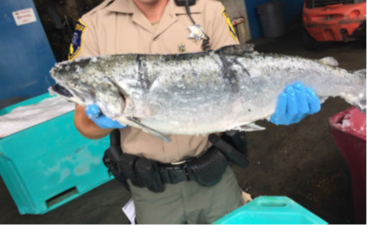
The Council received an enforcement update in June from NOAA Fisheries’ Office of Law Enforcement (OLE), West Coast Division. The West Coast Division provides marine enforcement and compliance assistance primarily for California, Oregon, and Washington, but also for a number of inland states.
OLE has ongoing agreements with all three West Coast states, and considers input from the Council and the public in setting and supporting its priority areas: sustainable fisheries; protected resources (species listed under the Endangered Species Act and Marine Mammal Protection Act); iIllegal, unreported, and unregulated fishing; seafood fraud; wildlife trafficking; and outreach and education.
Selected enforcement activities:
An Enforcement Officer investigated a commercial fishing vessel for conducting commercial fishing activities without a required Federal observer on board. The owner of the vessel was notified by phone and mail prior to beginning the fishing trips of the requirement, yet he failed to obtain mandatory observer coverage. A Notice of Violation was issued, with a settlement agreement of $11,250.
An investigation into a 2016 collision at sea between a commercial groundfish trawler and a commercial salmon troller revealed negligent conduct in maintaining a proper lookout and wheel watch. At the time of the collision, the trawl vessel was carrying a Federal fisheries observer, and the assigned bridge watch stander was not maintaining a proper wheel watch. While both vessels sustained damage in the at-sea collision, no one on either vessel was injured. A Notice of Violation was issued, with a settlement agreement of $5,175.
An officer investigated a non-groundfish trawl vessel for failure to operate and maintain a VMS over a four-month period while engaged in non-groundfish trawl fisheries. This resulted in a settlement agreement of $4,500.
Special Agents and Enforcement Officers investigated eleven referrals from the NMFS Sustainable Fisheries Division of groundfish and HMS permit holders that were delinquent in providing 2017 Economic Data Collection (EDC) forms and other required records. The Agents and Officers worked with company representatives to explain the importance of submitting the missing documents within regulatory timeframes. Six of the cases were closed with compliance assistance provided and the five others are being considered for escalated enforcement action, with one resulting in a Summary Settlement for $600.
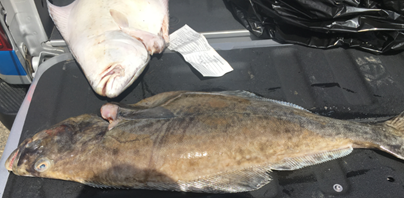
An officer boarded a commercial fishing vessel offloading albacore tuna at a first receiver. The vessel operator failed to complete an HMS logbook and failed to submit logbook pages from four earlier trips during the year. After determining the owner/operator had no prior violations, a written warning was issued. The owner/operator said he would help get the word out to the fleet to comply with logbook regulations.
An officer conducted an investigation into a vessel failing to coordinate with a required observer during fishing trips. Multiple incidents of failing to carry a required observer were documented; compliance assistance was provided, and the case was closed.
An officer investigated a self-report of a Rockfish Conservation Area (RCA) incursion by a trawl vessel. The vessel operator had incorrectly programmed waypoints into his plotter. As soon as he realized his incursion into the RCA, he called the Enforcement Officer and exited the RCA. The Enforcement Officer provided compliance assistance and the case was closed.
An officer investigated alleged observer harassment. The investigation revealed the behavior of the crew toward the observer was unprofessional, but it was determined no harassment had occurred. Compliance assistance was provided and the case was closed.
An individual picked up a baby harbor seal and brought it to his residence due to concerns about not seeing the animal’s mother nearby. The seal was reported to WDFW, which reported it to OLE. Due to the violation of the MMPA, an Enforcement Officer issued a Summary Settlement to the individual for $100.
An Officer received a complaint regarding an individual selling bait so that people could feed a local sea lion at the Santa Monica boardwalk. The Enforcement Officer made contact with the complainant and patrolled the area where the suspect was last seen. Unable to locate the suspect, the Enforcement Officer arranged with Santa Monica Harbor Police to post NOAA-approved signs that would inform the public not to feed the sea lions. The signs were posted and the case was closed with compliance assistance provided.
An Officer received a complaint that included a link to an Instagram video of an individual jumping into the water off Morro Bay, CA, to disentangle a humpback whale from fishing gear. The video showed the individual jump into the water, climb onto the back of the whale and cut ground line that was wrapped around the animal. The individual was provided compliance assistance, including information on proper reporting, the risk associated with his actions, and the violation committed. The individual was given contact information for the Marine Mammal Stranding Network for future reference.
An Officer completed an investigation into a recreational vessel operating within 200 yards of transient killer whales in Washington waters. The vessel owner was contacted and admitted to operating the vessel. A Summary Settlement was issued for $300.
Fisheries disaster relief funding moves forward
On April 15, Congressional representatives Kurt Schraeder, Mike Thompson, Suzanne Bonamici, and Peter DeFazio, and Senators Ron Wyden and Jeff Merkley, wrote to NOAA Fisheries to ask “that your administration work with our partners and constituents in the fisheries industry to give them the flexibility they need to protect both their workers and their businesses during the coronavirus pandemic.” See the full letter here.
On May 7 the Secretary of Commerce announced the allocation of $300 million in fisheries assistance funding provided by Sec. 12005 of the Coronavirus Aid, Relief, and Economic Security Act, also called the CARES Act, to states, Tribes, and U.S. territories with coastal and marine fishery participants who have been negatively affected by COVID–19.
NOAA Fisheries will use these allocations (see below) to make awards to partners including the Pacific States Marine Fisheries Commission (PSMFC). PSMFC will disburse the funds to address direct or indirect fishery-related losses as well as subsistence, cultural, or ceremonial impacts related to COVID-19.
Washington was granted $50 million; Oregon $15.9 million; California $18.3 million, and west coast tribes with federally-recognized fishing rights were granted $5 million.
PSMFC will coordinate with the west coast states and tribes to develop spending plans and distribute the funds. Information about development of spending plans is available on the following web sites: California, Washington, Oregon, PSMFC. In addition, please see the Council’s COVID-19 web page for more links to COVID resources.
Executive Order speeds up environmental review processes
On June 4th the President signed an Executive Order directing agencies under the Secretaries of Interior, Commerce, and Agriculture to expedite work on, and completion of, all authorized highway and associated infrastructure projects, civil works projects, energy projects, environmental projects, and natural resource projects.
The order requires expedited permitting timelines and processes for National Environmental Policy Act (NEPA) and Endangered Species Act/Essential Fish Habitat (ESA/EFH) consultations under emergency authority due to the COVID-19 pandemic.
This means either applying prior NEPA and ESA consultations to new projects without new consultations, or entirely exempting projects from these requirements.
This action could affect the Council’s ability to comment on permitting issues that impact EFH, particularly if a large number of projects impacting EFH are expedited or exempted.
The timeline for identifying expedited projects is July 4.
Executive Order promotes American seafood, expedites aquaculture projects
On May 7 the President signed an Executive Order (EO) to assist the U.S. commercial fishing and aquaculture industries.
Among other things, the EO aims to identify and remove unnecessary regulatory barriers that restrict American fishermen and aquaculture producers; combat illegal, unreported, and unregulated (IUU) fishing; avoid duplicative, wasteful or inconclusive permitting processes; facilitate aquaculture projects; and continue to hold imported seafood to the same food safety requirements as domestically produced products.
The EO requires each regional fishery management council to submit a list of actions, by November 2, 2020 that will within one year of the EO, reduce burdens on domestic fishing and increase production within sustainable fisheries.
The EO also requires the Secretary of Commerce issue a notice of proposed rulemaking to implement the United Nations Food and Agriculture Organization Agreement on Port State Measures to Prevent, Deter, and Eliminate Illegal, Unreported, and Unregulated Fishing.
The EO mandates major changes to commercial aquaculture regulation, with ambitious goals for expanding domestic seafood production through aquaculture. This includes developing nationwide permits for finfish, seaweed, and multi-species aquaculture, and identifying Aquaculture Opportunity Areas.
The U.S. Army Corps of Engineers must develop and propose the new nationwide permits within 90 days of the date of the Order, or by early August 2020. These nationwide permits could significantly streamline Federal permitting associated with such activities, similar to the nationwide permit previously approved by the Corps for shellfish aquaculture activities.
Within one year of the Order and each year for the following four years, the Secretary must identify at least two geographic areas containing locations suitable for commercial aquaculture and (within two years of identification), complete a programmatic EIS for each. In effect, this will likely allow significant expansion of domestic aquaculture, which currently require extensive environmental review (which often includes comment) before permits are approved.
The EO also instructs Interior, Agriculture, and Commerce, in consultation with the Joint Subcommittee on Aquaculture, to assess whether to revise the National Aquaculture Development Plan to improve the efficiency and predictability of aquaculture permitting, including whether revisions are required to identify restrictions to operate in specific areas for specific time periods. Learn more here.
[From sources including the National Law Review, Seafoodnews.com]
NMFS provides west coast whale entanglement summary for 2019
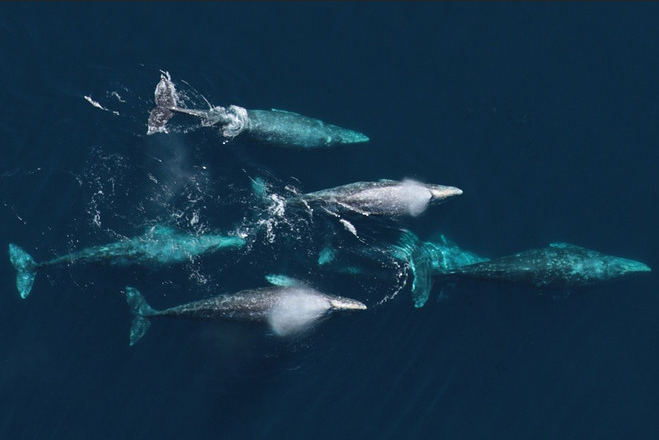
In 2019, west coast whale entanglement continued to be higher than what had occurred before 2014, although fewer reports were received than in some of the recent record high years. The data was provided in NMFS’ annual West Coast whale entanglement summary.
Twenty-six whales were confirmed entangled off the coasts of Washington, Oregon, and California in 2019. As in recent years, humpback whales were the most common species entangled, with 17 separate entanglements. Eight gray whales and one minke whale were entangled, as well as one leatherback sea turtle.
Of the 17 humpback entanglements, 13 occurred in California, 3 in Washington, and 1 in Mexico (with Oregon crab gear). Seven were entangled in various forms of crab gear, and ten were entangled in an unknown gear type. In six cases, some or all of the gear was removed from the whales. One humpback whale was known to have died as a result.
Of the eight confirmed gray whales entanglements, four occurred in Oregon, three in California, and one in Washington. Two were entangled in gillnets, one in a mooring buoy, and one in commercial Dungeness crab gear. One gray whale managed to free itself from the gear, and another whale had some of its gear removed. In another case, rescuers were unable to remove the gear. One gray whale died as a result.
The minke whale was entangled in unidentified gear and no attempt was made to remove the gear. The leatherback sea turtle was dead when discovered in rock crab gear off southern California.
Habitat report: beaver ponds, corals, and shellfish aquaculture
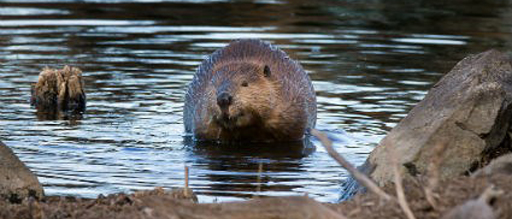
An Oregon win for beavers and salmon
A recent NMFS consultation on beaver, mink, nutria, and river otter management in Oregon found that both lethal and non-lethal removal of beaver would adversely affect essential fish habitat for Pacific salmon due to the loss of beaver ponds and the benefits they provide.
The consultation with the U.S. Department of Agriculture addressed Magnuson-Stevens Act and Endangered Species Act requirements. NMFS made four conservation recommendations to promote non-lethal management of beaver, monitoring and reporting, improving outreach to landowners, and beaver relocation efforts.
NMFS found that removal of the other three species would not adversely affect essential fish habitat. See related story from NMFS Northwest Fisheries Science Center: “Oregon beavers engineer better fish habitat, more fish; after four years, scientists recorded a 175 percent increase in juvenile steelhead.”
Klamath Basin issues
This spring the Bureau of Reclamation increased irrigation water supplies in the Klamath basin and shorted the amount of water sent to the river to avoid a disease outbreak in juvenile salmon. Reclamation increased Klamath Project allocation to 140 thousand acre-feet (TAF) and only provided 15 TAF of the 40 TAF dictated by the Klamath interim operations agreement.
Reclamation was sued by the Yurok Tribe and Pacific Coast Federation of Fishermen’s Associations over the 2020 Biological Assessment. The parties developed an interim agreement that provided more water for salmon in the mainstem Klamath River under certain hydrologic conditions, which were met this year. Reclamation’s action violated the interim agreement and may violate the NMFS Biological Opinion.
Based on the current operations plan, the Reclamation should have released a 40 TAF block of water to the Klamath River below Iron Gate Dam. Instead they increased the irrigation project supply from 80 TAF to 140 TAF and decreased the 40 TAF block that was to be released to the river to only 7 TAF.
After complaints from the tribes, resource agencies, and the technical flow advisory group, Reclamation released another pulse of 8,000 AF for a total of 15,000 AF, which is much less than the agreed-upon 40,000 AF. The 8,000 AF concession came late, after temperatures had cooled off and disease prevalence was down, instead of when water temperatures and disease prevalence were high. As a direct impact, nearly all the fish that were in the mainstem Klamath reach below Iron Gate dam during this time of high infection were impacted, which is is expected to be a significant portion of this year’s salmon cohort.
West Coast Deep Sea Coral Initiative Report
Tom Laidig (SWFSC) and Dr. Liz Clarke (NWFSC) presented to the HC on the West Coast Deep Sea Coral Initiative, which is funded by NOAA’s Deep Sea Coral Research and Technology Program and partners.
The Initiative focuses on partnership and collaboration for conducting deep sea surveys in support of mapping and exploration. In 2018 and 2019, more than 30 cruises were conducted off Washington, Oregon, and California in rockfish conservation areas that were closed for many years and will be reopened in 2021 as part of Groundfish Amendment 28. Researchers are collecting baseline data on fish and habitat-forming invertebrates (including corals and sponges) that can be used to assess the effects of reopening the areas to trawl fishing in the coming years.
Early results show increases of certain Lyssacine sponges on Daisy Bank, and increases of Swiftia pacifica corals on Coquille Bank (both off Oregon), indicating recruitment of these species in the last decade. Current technologies allow for long-term monitoring of selected sites, enabling scientists to distinguish between responses in habitat-forming invertebrates and fish densities and occurrences due to environmental variation and anthropogenic impacts.
Ventura Shellfish Enterprise Project
Ventura Shellfish Enterprise reported to the Habitat Committee (HC) on their plans to grow Mediterranean mussels off the coast of Ventura, CA on a grid of longlines in Federal waters. The project’s preferred alternative would convert 2,000 acres of the Santa Barbara channel to leased commercial aquaculture parcels. Many of the permitting processes have begun. Currently VSE is determining if they can conduct the project in Federal waters. The HC will continue to monitor this project and will keep the Council apprised of any important developments.
Council and advisory body appointments
Butch Smith has been appointed to the Washington obligatory seat on the Council, effective August 11. He replaces Rich Lincoln, who served three terms as a Council member. Brad Pettinger was reappointed his seat on the Council.
The Council elected Marc Gorelnik as Council chair for the 2020-2021 term, replacing Phil Anderson, who has served three years as Chair. Brad Pettinger will serve as Vice-Chair. The new terms will start August 11.
David McGowen was appointed to the vacant Northern Charter Boat Operator position on the Highly Migratory Species Advisory Subpanel formerly held by Linda Buell.
Dr. Xi He was appointed to the Southwest Fisheries Science Center position on the Groundfish Management Team formerly held by Dr. Andrew Thompson, and Dr.
Matthew Craig was appointed to the Southwest Fisheries Science Center position on the Highly Migratory Species Management Team formerly held by James Carretta. These two appointments will become effective following the September 2020 Council meeting.
Chairman Phil Anderson appointed the following additional NMFS Fisheries Science Center representatives to the Ad Hoc Ecosystem Workgroup: Dr. Andrew Thompson, Dr. Elliott Hazen, Dr. Mary Hunsicker, Dr. Andi Stephens, Dr. Jameal Samhouri.
Southern Resident Killer Whale Workgroup to hold online meeting August 3-4, 2020
This post was generated by and redirects to https://www.pcouncil.org/events/southern-resident-killer-whale-workgroup-to-hold-online-meeting-august-3-4-2020/.
Highly Migratory Species Management Team to hold online meeting July 27, 2020
This post was generated by and redirects to https://www.pcouncil.org/events/highly-migratory-species-management-team-to-hold-online-meeting-july-27-2020/.
Call for data and information – Essential Fish Habitat Review for Pacific Coast Highly Migratory Species
The Pacific Fishery Management Council, National Marine Fisheries Service (NMFS), and the NMFS Southwest Fisheries Science Center have initiated a review of essential fish habitat (EFH) provisions in the Pacific Coast Highly Migratory Species (HMS) Fishery Management Plan (FMP). This call for data and information is intended to support the review.
The HMS FMP, its EFH provisions, and maps can be found on our HMS webpage, under “Key Documents”. The HMS FMP includes the following species:
- Sharks: common thresher, shortfin mako, blue
- Tunas: albacore, bigeye, Pacific bluefin, skipjack, yellowfin
- Striped marlin
- Broadbill swordfish
- Dorado
Fishery management plans are required to identify and describe EFH for each life stage and species, identify and minimize impacts from fishing and non-fishing activities, and identify research needs, among other requirements. A complete description of EFH provisions to be included in FMPs can be found in the EFH regulatory guidance at 50 CFR§600.815(a). Information and data should be relevant to:
- The habitat needs, associations and distribution FMP species listed above
- Major prey items of species listed above
- Adverse impacts on EFH from fishing activities and potential minimization measures
- Adverse impacts on EFH from non-fishing activities and potential minimization measures
- Research and information needs
Information and data sources can include published scientific literature, unpublished scientific reports, information from interested parties, and previously unavailable or inaccessible data.
Information relevant to the HMS EFH review should be submitted to Nicole Nasby-Lucas (nicole.nasby-lucas@noaa.gov) no later than Monday July 13th, 2020. For further information, please contact Kerry Griffin (kerry.griffin@noaa.gov).
Pacific Council News Summer 2020: Groundfish
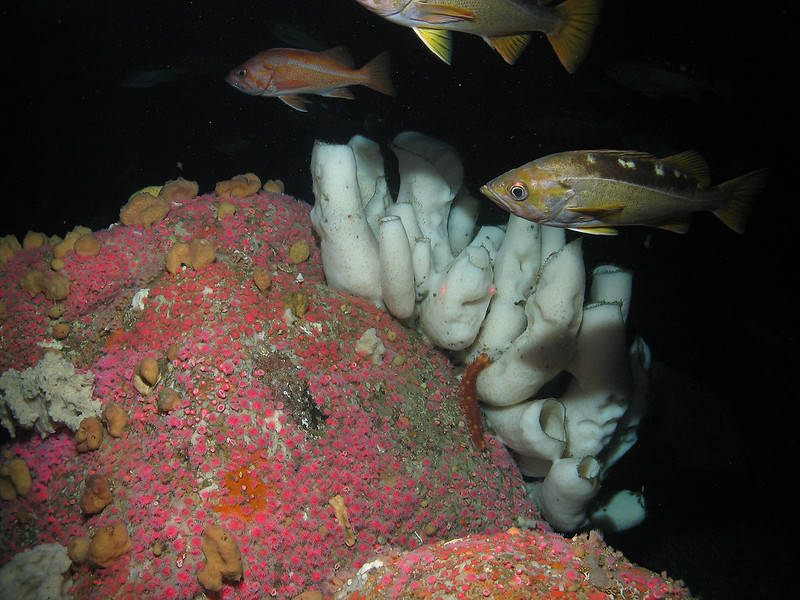
Six exempted fishing permits move forward
The Council has forwarded six 2021-2022 exempted fishing permits (EFP) applications to NMFS. They focus on year-round coastwide midwater rockfish; California Department of Fish and Wildlife recreational cowcod sampling in California; yellowtail rockfish Jig fishing off California; commercial midwater hook-and-line rockfish in the Rockfish Conservation Area off Oregon; Washington Department of Fish and Wildlife enhanced yelloweye recreational fishery biological sampling; and the Monterey regional EFP targeting chilipepper rockfish.
An EFP authorizes a vessel to engage in an activity that is otherwise prohibited in order to collect experimental data. The objectives of EFPs vary, and may include promoting increased utilization of underutilized species, increasing harvest efficiency, exploring ways to reduce effort on depressed stocks, encouraging innovation and efficiency in the fisheries, providing access to stocks while measuring the bycatch, or evaluating proposed management measures.
Two EFPs are noteworthy because they are new this cycle. The CDFW EFP will investigate cowcod catch in the recreational fishery, reflecting the rebuilt status of cowcod. The EFP will improve scientists’ and managers’ understanding of the species. Additionally, the WDFW EFP will investigate yelloweye rockfish catch in the recreational fishery. This EFP will provide more knowledge about how the recreational fishery impacts the species, and is key to improved understanding of how the species is rebuilding.
Final harvest specifications and management measures adopted for 2021, 2022
In June the Council adopted final 2021 and 2022 harvest specifications for stocks and stock complexes by confirming their April 2020 decision for all stocks except shortbelly rockfish, which will be designated an Ecosystem Component species.
Concerns over incidental shortbelly bycatch prompted the Council to recommend that if the fishery exceeds 2,000 mt of shortbelly rockfish in a calendar year, the Council will investigate the reasons why the overage occured. The Council could then consider changing management measures for shortbelly based on the results. The Groundfish Management Team (GMT) will continue to monitor the stock, and inseason catches will be tracked using the species scorecard.
The Council adopted its preliminary preferred alternative as the preferred alternative for routine management measures, which include annual catch limit deductions for tribal, research, recreational, exempted fishing permit, and incidental open access fisheries, as well as set-asides for the at-sea whiting fisheries. These measures are summarized here and detailed here.
The Council also adopted trip limits for incidentally-caught yellowtail rockfish in salmon troll fisheries both north and south of 40° 10’ N. lat. For the salmon troll fishery north of 40° 10’ N. lat., the Council eliminated the salmon-to-yellowtail ratio requirement and recommended a monthly trip limit of 500 lbs of yellowtail rockfish, with the additional requirement that salmon must be included in the landing. For the salmon troll fishery south of 40° 10’ N. lat, the Council adopted 1 lb. of yellowtail rockfish per 2 lb. of Chinook salmon landed, with a cumulative monthly limit of 200 lbs. of yellowtail rockfish.
The Council adopted the GMT’s recommended harvest guidelines and allocations and established a 50 mt annual catch target for cowcod south of 40° 10’ N. lat. Further, they confirmed the two-year trawl/non-trawl and commercial trip limit for all stocks that were in the preliminary preferred alternative.
Flatfish gear restrictions within the non-trawl Rockfish Conservation Area (RCA) south of 42° N. lat were removed. The Council established a 50 lbs-per-month shortspine thornyhead and 50 lbs.-per-month longspine thornyhead trip limit north of 34° 27’ N. lat. The Council also converted widow rockfish, petrale sole, lingcod south of 40° 10’ N. lat, and Slope Rockfish complex (including blackgill rockfish) allocations from Amendment 21 formulas to new two-year allocations.
The Council adopted the recreational management measures recommended by the California Department of Fish and Wildlife, the Oregon Department of Fish and Wildlife, and the Washington Department of Fish and Wildlife, as well as the treaty tribal management measures recommended by the tribes.
Additionally, the Council adopted multiple depth adjustments to the non-trawl RCA off California, Oregon, and Washington.
In California, recreational management area depth changes to the RCA were adjusted as follows:
- Mendocino Groundfish Management Area (Cape Mendocino to Point Arena): Increase the allowable depth during the open season (May through October) from 20 to 30 fathoms.
- San Francisco Groundfish Management Area (Point Arena to Pigeon Point): Increase the allowable depth during the open season (April through December) from 40 to 50 fathoms.
- Southern Groundfish Management Area (Point Conception to the U.S.-Mexico border): Increase the allowable depth during the open season (March through December) from 75 to 100 fathoms.
Also in California, commercial non-trawl RCA depth boundaries were adjusted as follows:
- A new management line was created at 38° 57.5′ N. lat. (Point Arena) in order to define RCA boundaries.
- Between 38° 57.5′ and 34° 27′ N. lat. (Point Arena to Point Conception), the depth of the shoreward RCA boundary was increased from 40 to 50 fathoms. (The shoreward RCA depth between 40° 10′ N. lat. and 38° 57.5′N. lat. will remain unchanged at 40 fathoms.)
- From 34° 27′ N. lat. (Point Conception) to the U.S.-Mexico border, the depth of the shoreward RCA boundary was increased from 75 fathoms to 100 fathoms.
The Council also recommended moving the shoreward boundary of the non-trawl RCA from 30 fm to 40 fm between 40° 10’ N. lat. and the Oregon/Washington border (46° 16’ N. lat) and to allow only hook and line gear, except for dinglebar and longline, to be used. Dinglebar and longline gear types (as defined at 50 CFR 660.11) cannot be fished in this area and depth range..
Finally, the Council recommended reopening the South Coast and Westport Yelloweye Rockfish Conservation Areas off Washington.
NMFS will next submit a preliminary rule for public review, and is set to finalize the regulations with a target implementation date of January 1, 2021.
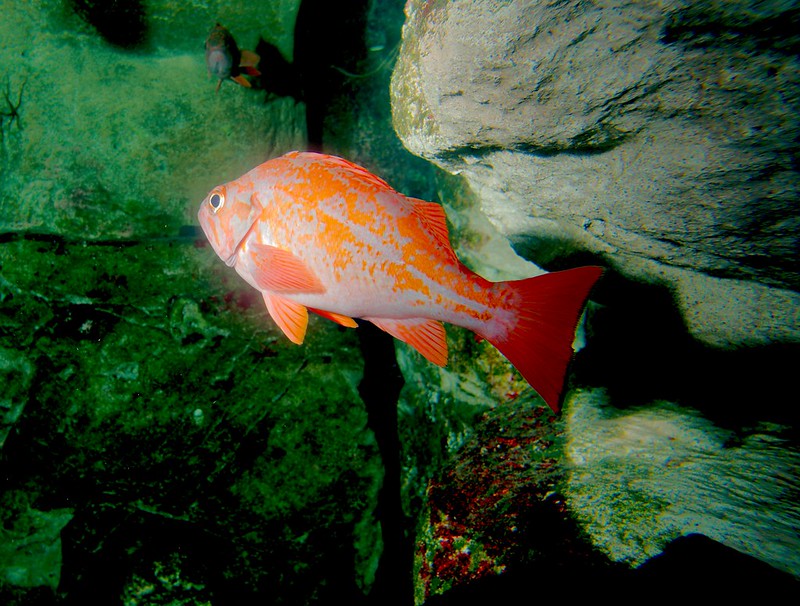
Groundfish stock assessment finalized for 2021
In June the Council adopted groundfish stock assessments to be conducted in 2021 as follows: full assessments for vermilion and sunset rockfishes (to be assessed as a complex of the two species), Dover sole, and lingcod; data-moderate assessments for spiny dogfish, copper rockfish, quillback rockfish, and squarespot rockfish; an update assessment of sablefish; and catch-only projection updates for arrowtooth flounder, canary rockfish, darkblotched rockfish, and petrale sole.
Three Stock Assessment Review (STAR) panels will be held next year to review the full assessments, with one panel devoted to vermilion and sunset rockfishes and one panel devoted to lingcod. A third STAR panel will review the full assessment for Dover sole and the data-moderate assessment for spiny dogfish, which is expected to be complex and in need of a more robust review process.
The Council also adopted a list of candidate stocks for assessment in 2023 as follows: petrale sole, black rockfish, sablefish, rougheye rockfish, shortbelly rockfish, and redbanded rockfish are candidates for full assessments; yellowtail rockfish north of 40° 10’ N lat. is a candidate for a full or updated assessment; yellowtail rockfish south of 40° 10’ N lat., greenspotted rockfish, and flathead sole may be subject to full or data-moderate assessments; bank rockfish, brown rockfish, starry rockfish, longspine thornyhead, shortspine thornyhead, English sole, rex sole, treefish, olive rockfish, and speckled rockfish are candidates for data-moderate assessments; yelloweye rockfish is a candidate for an updated assessment. (Italicized stocks are higher priority). Advance notice of stock assessment priorities is considered helpful in prioritizing data collection efforts. A final decision on 2023 stock assessment priorities is scheduled for June 2022.
Council adopts final changes to electronic monitoring regulations
Final changes to West Coast electronic monitoring program regulations were adopted by the Council in June, including a recommendation that implementation of the program be delayed until January 1, 2022.
The Council recommended that National Marine Fisheries Service (NMFS) extend the existing electronic monitoring exempted fishing permits (EFPs) until the amended regulations take effect, and allow new EFP entrants to continue developing catch handling rules in the bottom trawl fishery.
The regulatory changes will include increasing the hard drive submission deadline to 72 hours from the beginning of the offload, and requiring that data be removed before reusing hard drives only if end-to-end encryption is not used; removing the limit on switching between observers and electronic monitoring for whiting vessels; removing the requirement for a mothership/catcher vessel endorsement to use electronic monitoring on mothership catcher vessel trips; allowing providers to receive and enter logbook information, rather than submitting it to NMFS; requiring deadlines for service provider reports, logbook data, vessel operator feedback, summary and data compliance reports; aligning data retention requirements with NMFS directives; and making minor corrections to regulations and definitions.
The NMFS and the Council will continue to develop the electronic monitoring program guidelines and provider manual to ensure it is consistent with the revised proposed rule and other directives. Public webinars will be held during the summer and fall of 2021 to discuss their development. Please visit the Council’s electronic monitoring page for more information.
Inseason adjustments
The Council increased bocaccio south of 40° 10’ N. lat. trip limits for limited entry fixed gear (LEFG) and open access. The recommended inseason adjustments would set the bocaccio trip limits for LEFG from 40° 10’ North latitude (N. lat.) to 34° 27’ N. lat at 6,000 lbs per two months; LEFG south of 34° 27’ N. lat. at 6,000 lbs per two months; and the open access trip limits for bocaccio south of 40° 10’ N. lat. at 4,000 lbs per two months.
Sablefish Management and Trawl Allocation Attainment Committee provides final report to the Council
The Sablefish Management and Trawl Allocation Attainment Committee (SaMTAAC) submitted its final report in June. The committee was created to address under-attainment of non-sablefish trawl allocations and unharvested sablefish quota pounds south of 36° N. latitude.
The SaMTAAC’s final report to the Council includes a “no action” alternative and three alternatives that would limit the harvest of northern sablefish by vessels using non-trawl gear in the trawl catch share fishery. When the Council takes its next action on this issue in September, it will decide whether or not to move the deliberations forward, and, if so, adopt a purpose and need and consider further development of alternatives.
Pacific Council News Summer 2020: Salmon

Workgroup meets to look into new management approach for southern Oregon/northern California coast coho
The ad hoc Southern Oregon/Northern California Coast Coho Workgroup met for the first time in June to support the Council in its efforts to develop a new management approach for southern Oregon/northern California coast coho.
NMFS requested the Council assist in its consultation process in response to a court agreement with the Hoopa Valley Tribe, which alleged that NMFS had failed to reinitiate Endangered Species Act consultation on the impacts of ocean salmon fisheries on the stock.
The Council formed the workgroup to develop a harvest control rule for Southern Oregon/Northern California coast coho, and will be guided by the terms of reference which outline the workgroup’s purpose, milestones, and schedule. The Council is scheduled to provide a final recommendation to NMFS in November 2021.
A roster and tentative schedule is in the Workgroup’s progress report provided in June. Their next meeting is scheduled for August 6-7, 2020 and will focus on cataloging existing data (and identifying data gaps), and discussing concepts for potential harvest control rules.
Final risk assessment for Southern Resident killer whales adopted
In June the Council adopted the ad hoc Southern Resident Killer Whale Workgroup’s final risk assessment, which assesses the effects of Council-managed ocean salmon fisheries on the Chinook salmon prey base of Southern Resident killer whales. The Scientific and Statistical Committee reviewed and supported the analytical methods and materials in the assessment.
The Workgroup was also tasked with recommending potential conservation measures or management tools to limit fishery impacts on the prey base as needed, and has shifted its focus to that aspect of its task.
The Workgroup met in April to begin drafting recommendations for salmon management measures based on the assessment. It plans to meet again between the June and September Council meetings to continue developing recommendations for the Council.
The Workgroup will work closely with the Salmon Advisory Subpanel and stakeholders during this process. Any recommendations developed for Council consideration will go through the Council process to solicit industry input and public comment. The Council will eventually provide its recommendations to NMFS. The Council is currently scheduled to discuss this topic in September and November 2020.
Council focuses on salmon management schedule, boundary change
The Council and NMFS are working to improve the salmon management schedule and make a boundary adjustment through an amendment to the fishery management plan.
The first change, proposed by NMFS, would alter the salmon management schedule to avoid instances where regulations cannot be processed in time for the traditional start of the season, May 1.
The second change was proposed by the commercial salmon troll industry and is focused on moving the salmon management boundary line between the Klamath Management Zone (KMZ) and the Fort Bragg Management Zone from latitude 40° 05’ (Horse Mountain, California) five nautical miles north to latitude 40° 10’ to ease enforcement and increase safety. The current groundfish management boundary is at 40° 10’ N. lat., and the additional area would allow safer maneuvering nearshore when the Fort Bragg area is open (the southern KMZ is closed to commercial trolling).
The Council began the process of amending the Pacific Salmon Fishery Management Plan in November 2019 and aims to complete these changes in time for the 2021 ocean salmon season. In June the Council adopted a range of alternatives for public review that covers both the preseason schedule change and the boundary change. The alternatives are consistent with those found in this report, with the addition of a third alternative to keep the five-nautical-mile area closed to commercial fishing when low Chinook abundance calls for ‘de minimis‘ fishing.
Coastal Pelagic Species Subcommittee of the Scientific and Statistical Committee to hold online meeting July 15-16, 2020
This post was generated by and redirects to https://www.pcouncil.org/events/coastal-pelagic-species-subcommittee-of-the-scientific-and-statistical-committee-to-hold-online-meeting-july-15-16-2020/.
PRELIMINARY DRAFT JUNE 2020 MOTIONS IN WRITING
Cautionary Note — These preliminary motions do not represent the final official administrative record. The motions and amendments contained in this blog are as projected on the screen at the Council meeting at the time of the Council vote and often use expedited language and references without the benefit of any final editing or proofing. They may use short-hand language or abbreviations that may not be clear without the context of verbal comments and clarifications made during their development at the meeting, or may contain inadvertent transposition errors. They have not been approved by the Council to represent the final official record of Council action. The final official record will be posted on the Council website after the Council approves the full meeting record at a future Council meeting.
- E.1 – Adopt the terms of reference and provide guidance on future work and schedule
- E.2 – Adopt final risk assessment, review draft SRKW Workgroup management measure recommendations, and provide guidance
- E.3 – Review progress on Amendment 20, adopt a range of alternatives, and consider preliminary alternatives, as appropriate.
- C.2 – Consider budget committee report and recommendations.
- G.1 – Review draft rebuilding plan, adopt a range of alternatives, and consider a preliminary preferred alternative, as appropriate.
- F.2 – Adopt final list and schedule of Groundfish stocks for assessment in 2021, the stock assessment and methodology review TOR for Groundfish and Coastal Pelagic Species, and the rebuilding TOR for overfished Groundfish Stocks; refine the preliminary list of stocks for 2023 assessments.
- F.3 – Adopt final recommendations for regulatory changes, program implementation, and exempted fishing permits.
- F.1 – Final exempted fishing permit recommendations and final preferred management measures for 2021-2022 fisheries
- F.4 – Groundfish inseason adjustments — final action
- C.4- Consider appointments to Council committees and advisory bodies; adopt changes to Council operating procedures
- C.3 – Approve previous Council meeting records
Ad Hoc Climate and Communities Core Team to hold online meeting July 1, 2020
This post was generated by and redirects to https://www.pcouncil.org/events/ad-hoc-climate-and-communities-core-team-to-hold-online-meeting-july-1-2020/.